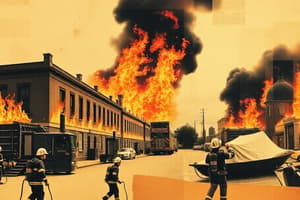Podcast
Questions and Answers
What is the primary objective of an initial fire attack in both offensive and defensive plans?
What is the primary objective of an initial fire attack in both offensive and defensive plans?
- To write off lost property quickly
- To provide ventilation before any attack
- To conduct a secondary search of the building
- To attack the fire from the most advantageous position with appropriate water volume (correct)
During an incident size up, what factor is crucial for determining the next steps in both offensive and defensive plans?
During an incident size up, what factor is crucial for determining the next steps in both offensive and defensive plans?
- Assessing public safety measures
- Evaluating previous fire incidents in the area
- Determination of critical factors (correct)
- Conducting a thorough investigation of the scene
Which of the following is a focus of the basic defensive plan but not explicitly mentioned in the offensive plan?
Which of the following is a focus of the basic defensive plan but not explicitly mentioned in the offensive plan?
- Conduct a primary search in coordination with fire attack
- Address fire extension and life safety in exposures (correct)
- Provide coordinated support activities
- Assume command swiftly upon arrival
What must be ensured to support a high-volume fire attack according to the defensive plan?
What must be ensured to support a high-volume fire attack according to the defensive plan?
What action is recommended when evaluating actions during an incident in both plans?
What action is recommended when evaluating actions during an incident in both plans?
What is the first action required in both offensive and defensive plans?
What is the first action required in both offensive and defensive plans?
In the defensive plan, what is the main focus regarding incidents that are deemed lost?
In the defensive plan, what is the main focus regarding incidents that are deemed lost?
Which action is crucial for fire attack in both offensive and defensive plans?
Which action is crucial for fire attack in both offensive and defensive plans?
What must be considered when evaluating actions in both offensive and defensive plans?
What must be considered when evaluating actions in both offensive and defensive plans?
What is a primary concern when addressing exposures in the defensive plan?
What is a primary concern when addressing exposures in the defensive plan?
Flashcards are hidden until you start studying
Study Notes
Basic Offensive Plan
- Command is established to direct operations during the incident.
- Initial assessment includes sizing up the incident and identifying critical factors that may impact the operation.
- Fire attack is launched from the most advantageous position using an appropriate volume of water to control the flames effectively.
- A primary search is conducted simultaneously with the fire attack when feasible, prioritizing life safety.
- Support activities include coordination of ventilation and forcible entry to enhance fire control effectiveness.
- Firefighters support the attack from secondary advantageous positions while maintaining adequate water volume for continued suppression.
- Focus on loss control and property conservation to minimize damage to structures and properties.
- Continuous evaluation of actions is essential, allowing for adjustments of strategies and tactics based on effective assessments.
Basic Defensive Plan
- Command is established to lead the defensive operations in emergencies.
- Initial size-up determines the extent of the incident and critical factors influencing tactics.
- Identify what can be written off due to fire damage while focusing on protecting savable structures and exposures.
- Engage in fire suppression from advantageous positions, utilizing large volume devices and strategic placements for maximum effectiveness.
- Support is organized to meet the needs of a high-volume fire attack, ensuring necessary water supply and pumping capabilities are in place.
- Maintain adequate resources to fully support firefighting operations and other necessary activities.
- Address fire extension, life safety, and loss control measures for exposures when the risk management strategy allows for such actions.
- Continuous evaluation is crucial for reevaluating tactics and adjusting operational strategies as needed.
Basic Offensive Plan
- Command is established to direct operations during the incident.
- Initial assessment includes sizing up the incident and identifying critical factors that may impact the operation.
- Fire attack is launched from the most advantageous position using an appropriate volume of water to control the flames effectively.
- A primary search is conducted simultaneously with the fire attack when feasible, prioritizing life safety.
- Support activities include coordination of ventilation and forcible entry to enhance fire control effectiveness.
- Firefighters support the attack from secondary advantageous positions while maintaining adequate water volume for continued suppression.
- Focus on loss control and property conservation to minimize damage to structures and properties.
- Continuous evaluation of actions is essential, allowing for adjustments of strategies and tactics based on effective assessments.
Basic Defensive Plan
- Command is established to lead the defensive operations in emergencies.
- Initial size-up determines the extent of the incident and critical factors influencing tactics.
- Identify what can be written off due to fire damage while focusing on protecting savable structures and exposures.
- Engage in fire suppression from advantageous positions, utilizing large volume devices and strategic placements for maximum effectiveness.
- Support is organized to meet the needs of a high-volume fire attack, ensuring necessary water supply and pumping capabilities are in place.
- Maintain adequate resources to fully support firefighting operations and other necessary activities.
- Address fire extension, life safety, and loss control measures for exposures when the risk management strategy allows for such actions.
- Continuous evaluation is crucial for reevaluating tactics and adjusting operational strategies as needed.
Studying That Suits You
Use AI to generate personalized quizzes and flashcards to suit your learning preferences.




